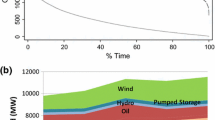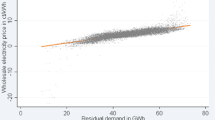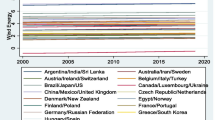Abstract
This research models the drivers of emissions historically to identify the factors most effective in reducing power system emissions. It estimates the average effects of wind and load on \(\hbox {CO}_{2}\) emissions from the Republic of Ireland’s electricity market. The findings suggest that wind generation and load reduction are not equally effective on average in terms of reducing emissions and that a 1 MW increase in wind is approximately 65% on average as effective at reducing emissions as a 1 MW load reduction, a result in line with existing literature. However, the results also show that a reduction in load and an increase in wind have a similar impact on emissions if wind forecast errors are explicitly modelled. Thus, the emissions reduction differentiation may not only be driven by the timing of load and wind output, the wind forecast error also has an important role. Positive and negative wind forecast errors are found to have opposite effects on emissions.





Similar content being viewed by others
Notes
One of the benefits of DSM is demand smoothing, whereby demand from peak hours is reduced and shifted to periods of lower demand, however we focus on an absolute reduction in demand in this study.
Baseload plants are used to meet a system’s minimum continuous energy demand.
The authors also considered quadratic specifications of the models but these were found to reduce the predictive power of the models with coefficients of zero on the quadratic variables and thus the results of these models are not displayed here.
References
Kyoto Protocol: The Kyoto Protocol to the United Nations Framework Convention on Climate Change. UNEP/WMO, Kyoto (1997)
CAA: Clean Air Act as of 2008. U.S. Government Publishing Office, Washington DC, USA (2008)
European Commission: Directive (2003/87/EC). Official Journal of the European Union (2003)
European Commission: Directive (2004/101/EC). Official Journal of the European Union (2004)
Australian Government: Clean energy act. Act No. 131 of 2011 (2001)
Renewable Energy Sources Act (EEG): Bundesgesetzblatt bgbl i 2000, 305 (2000)
Energy Independence and Security Act of 2007: Public law 110140 (2007)
European Commission: Directive (2009/28/EC). Official Journal of the European Union (2009)
Ofgem: Renewables Obligation Annual Report 2011-12. Office of Gas and Electricity Markets, London, UK (2013)
DCENR: Department of Communications, Energy and Natural Resources Ireland, Government white paper: delivering a sustainable energy future for Ireland (2007)
Ministere de l’Ecologie, de l’Energie, du Developpement durable et de la Mer: National action plan for the promotion of renewable energies (2009)
GWEC: Global wind report, annual market update 2014. Global Wind Energy Council, Brussels, Belgium (2015)
EWEA: Wind in power. 2014 European Statistics (2015)
Dietz, T., Gardner, G.T., Gilligan, J., Stern, P.C., Vandenbergh, M.P.: Household actions can provide a behavioral wedge to rapidly reduce U.S. carbon emissions. Proc. Natl. Acad. Sci. 106(44), 18452–18456 (2009)
Holland, S.P., Mansur, E.T.: Is real-time pricing green? The environmental impacts of electricity demand variance. Rev. Econ. Stat. 90(3), 550–561 (2008)
Troy, N., Denny, E., O’Malley, M.: Base-load cycling on a system with significant wind penetration. IEEE Trans. Power Syst. 25, 1088–1097 (2010)
O’Mahoney, A., Denny, E.: Electricity prices and generator behaviour in gross pool electricity markets. Energy Policy 63, 628–637 (2013)
Yik, F., Lee, W.: Rebate as an economic instrument for promoting building energy efficiency in Hong Kong. Build. Environ. 40(9), 1207–1216 (2005)
Strbac, G.: Demand side management: benefits and challenges. Energy Policy 36, 4419–4426 (2008)
Denny, E., O’Malley, M.: Wind generation, power system operation, and emissions reduction. IEEE Trans. Power Syst. 21, 341–347 (2006)
ERCOT: Analysis of potential impacts of CO2 emissions limits on electric power costs in the ERCOT region. Electric Reliability Council of Texas, Austin, United States (2009)
Deng, L., Renson, P., Hobbs, B.F.: What is the cost of negative bidding by wind? A unit commitment analysis of cost and emissions. IEEE Trans. Power Syst. 30(4), 1805–1814 (2015)
Delarue, E.D., Luickx, P.J., D’haeseleer, W.D.: The actual effect of wind power on overall electricity generation and costs and CO\(_{2}\) emissions. Energy Convers. Manag. 50(6), 1450–1456 (2009)
Bentek Energy LLC: The wind power paradox. Technical report (2011)
Forbes, K., Stampini, M., Zampelli, E.: Wind energy, the price of carbon, and carbon emissions: evidence from Ireland. In: 2011 International Energy Workshop, Stanford University (2011)
Malaguzzi-Valeri, L., di Cosmo, V.: The effect of wind on CO\(_{2}\) emissions: the case of Ireland. ESRI working paper. http://www.esri.ie/pubs/WP493.pdf (2015)
Wheatley, J.: Quantifying CO\(_{2}\) savings from wind power. Energy Policy 63(3), 89–96 (2013)
Cullen, J.: Measuring the environmental benefits of wind-generated electricity. Am. Econ. J. Econ. Policy 5(4), 107–33 (2013)
Kaffine, D., McBee, B., Lieskovsky, J.: Emissions savings from wind power generation in Texas. Energy J. 34(1), 155–175 (2013)
Marcantonini, C., Ellerman, A.D.: The cost of abating CO\(_{2}\) emissions by renewable energy incentives in Germany. In: 10th International Conference on the European Energy Market (EEM), pp. 1–8. IEEE, Stockholm (2013)
Gowrisankaran, G., Reynolds, S., Samano, M.: Intermittency and the value of renewable energy. J. Polit. Econ. 124(4), 1187–1234 (2016)
Novan, K.: Valuing the wind: renewable energy policies and air pollution avoided. Am. Econ. J. Econ. Policy 7(3), 291–326 (2015)
Kirschen, D.: Demand-side view of electricity markets. IEEE Trans. Power Syst. 18, 520–527 (2003)
O’Sullivan, J., Rogers, A., Flynn, D., Smith, P., Mullane, A., O’Malley, M.: Studying the maximum instantaneous non-synchronous generation in an island system: frequency stability challenges in Ireland. IEEE Trans. Power Syst. 29, 2943–2951 (2014)
Eirgrid: All-island wind and fuel mix summary report. Eirgrid & Soni Operations (2013)
SEM: Market schedules of the Irish single electricity market. Single Electricity Market Operator, Dublin, Ireland (2013)
Eirgrid: TSO connected wind farms. Eirgrid Group, Dublin, Ireland (2012)
ESB Networks: DSO energised-connected wind generators. ESB Networks, Dublin, Ireland (2012)
CER: Cost–benefit analysis (cba) for a national gas smart metering rollout in Ireland. Information Paper, vol. CER11180c (2011)
CSO: Number of private households and persons in private households in each province, county and city. Households by County, Year, Statistic and Type of Ownership. Central Statistics Office, Cork, Ireland (2006)
SEAI: Wind Energy Workshops (2010)
CER: Electricity smart metering customer behaviour trials (cbt) findings report. Information paper CER11080a (2011)
Rajbhandari, N., Li, W., Sharma, S., Blevins, B.: Analysis of net-load forecast error and new methodology to determine non-spin reserve service requirement. In: Power and Energy Society General Meeting, pp.1–5. IEE, Boston (2016)
Author information
Authors and Affiliations
Corresponding author
Additional information
The views expressed in this paper are those of the authors and do not necessarily represent the views of, and should not be attributed to, Ofgem or the Gas and Electricity Markets Authority. This work was conducted in part while Amy O’Mahoney was at Trinity College Dublin, and visiting Johns Hopkins, and was funded by Teagasc under the Walsh Fellowship Programme and the Electricity Research Centre (ERC). Ben Hobbs was supported by NSF Grants IIA 1243482 and ECCS 1230788. This work was conducted in part while Eleanor Denny was a visiting scholar at the Harvard Environmental Economics Program, Harvard University, Cambridge, MA 40215, USA.
Rights and permissions
About this article
Cite this article
O’Mahoney, A., Denny, E., Hobbs, B.F. et al. The drivers of power system emissions: an econometric analysis of load, wind and forecast errors. Energy Syst 9, 853–872 (2018). https://doi.org/10.1007/s12667-017-0253-9
Received:
Accepted:
Published:
Issue Date:
DOI: https://doi.org/10.1007/s12667-017-0253-9




